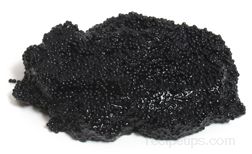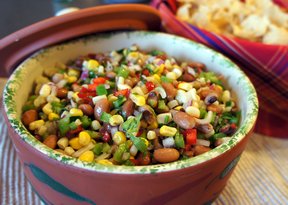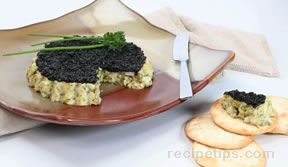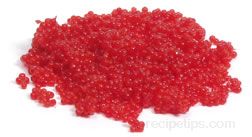Similar Content to: Cavendish Banana

Caviar is graded according to the characteristics of the grain or berries, terms used to describe the individual eggs. The key characteristics for grading include: uniformity, texture, size, color, flavor, fragrance, firmness, and the gleam. Larger sized eggs are consided to be the best. Lighter colored Caviar, such as grey Caviar is considered to be of higher quality and flavor than darker colors such as black. Caviar that tastes salty is considered to be of lower quality, so many producers add only mininmal salt (3% to 5% of volume) to preserve the roe. If more salt is added it will tend to dry out the eggs and the liquid surrounding the eggs. A good Caviar should be lacking in a fishy taste and be more buttery or savory in flavor.
The Beluga roe is larger in size, consistent with the Beluga being the largest of the sturgeon species. The roe is light grey to black in color and provides a smooth, delicate tasting Caviar that is generally the most expensive of the three varieties. The Osetra roe, which are yellowish gold to brownish grey in color are medium in size when compared to Beluga and Sevruga. They provide a somewhat nutty flavor that may be considered more robust and desirable to Beluga or Sevruga. The smallest of the eggs come from the Sevruga roe, which are greyish black in color and asltier or more intense in flavor. Sevruga Caviar is the least expensive of the three. A fourth alternative is a combination of all three Caviars, which is referred to as "pressed" Caviar. Salty and fishier in flavor, this Caviar consists of a mixture of broken and martured eggs from the three varieties.
Other varieties of Caviar are also available, which come from fish such as capelin, hackleback, lumpfish, paddlefish, salmon, trout, tuna (bottarga), and whitefish many of which are common to the United States and other regions of the world. Capelin roe may be black or bright pink in color, the pink variety being the roe often used as a topping for sushi. Capelin comes from the waters of Iceland and is considered a lower grade of Caviar. Lumpfish is considered to be a very low grade of Caviar with little flavor and a salty tasting roe. Chum salmon that are caught along the Northwestern U.S. coastal waters and rivers provide the majority of salmon Caviar. Typically, these fish are providing a less expensive Caviar with a smaller-sized berry that is saltier in flavor, crisp in texture and not as rich or delicate tasting as the sturgeon varieties. Caviar from farm raised fish can also be considered as a good alternative to more expensive varieties. As Caviar producers develop alternative types, they are also developing alternative flavors, such as truffle and wasabi flavors in an effort to enhance the taste of the roe and broaden the market for Caviar.
When selecting Caviar, choose fresh Caviar whenever possible. The eggs should appear plump, unbroken and consistent in size. As they are eaten, the eggs will resist slightly and then "pop" as they are broken open by the teeth. Bottled or canned Caviar is also available which will not be as flavorful as the fresh variety. When packed for shipment, keep fresh Caviar in an airtight container surrounded by ice. Excessive exposure to air will damage the Caviar, so it is best to keep well sealed until use. Caviar is often packed in oil with salt to preserve the texture and flavor. Too much oil adds too much liquid substance while too much salt only serves to dry out the Caviar, so make sure the Caviar is not packed in an excessive amount of oil or salt. After Caviar is opened and if there is some leftover, it is best to cover the top of the caviar with plastic wrap and then seal the tin or bottle shut. In an effort to increase the shelf life of Caviar, some producers will pasteurize the product. Unfortunately, the pasteurization process decreases the flavor of the product giving it a more bland taste and often hardens the egg texture. Pasteruized eggs don't have the "pop" quality when eaten and tend to simply "crush" between the teeth.
Store Caviar in an air-tight container, close to the coldest section of the refrigerator without freezing it. Unopened, it can be kept refrigerated for 2 to 3 weeks. Caviar should be served as soon as possible after it is purchased and should not be stored for more than 1 to 2 days after opening. Similar to wine, Caviar is adversely affected by exposure to air, so keep the Caviar as cold as possible at all times and tightly covered in an airtight container when stored. Keeping Caviar at temperatures between 28ºF to 32ºF is best to preserve the freshness and flavor.
When preparing, remove the Caviar from the refrigerator approximately 1 hour before serving and place the Caviar in a bowl that is then set within a container holding ice. A common serving suggestion is to use a small round cracker or a small Russian pancake known as a blini, approximately 2 inches in diameter. Place a dollop of crème fraîce on the cracker or blini and top with Caviar. Caviar is commonly eaten with crackers or small toasts as an appetizer, however it can also be served as a garnish to meat and fish dishes or potatoes and as a complement to other food dishes. As an appetizer it is often accompanied by hard boiled eggs, chopped onions, sour cream or crème fraîche, and wedges of lemon. Adding fresh lemon juice to the Caviar will enhance the flavor of a bland tasting batch of eggs. Add 2 tablespoons of juice to each ounce of roe. Allow approximately 1 to 2 ounces of Caviar per person.











